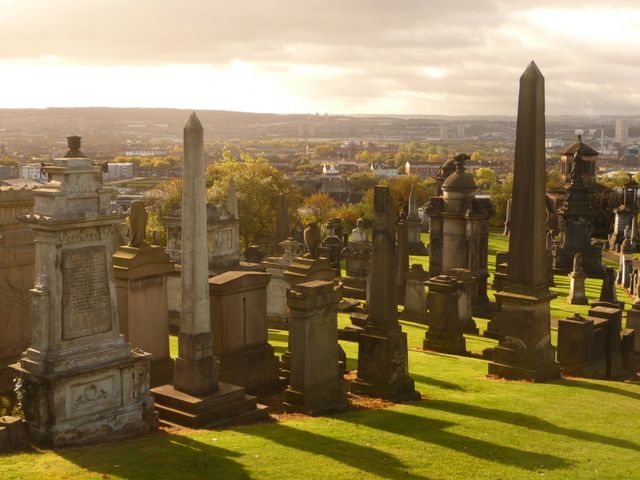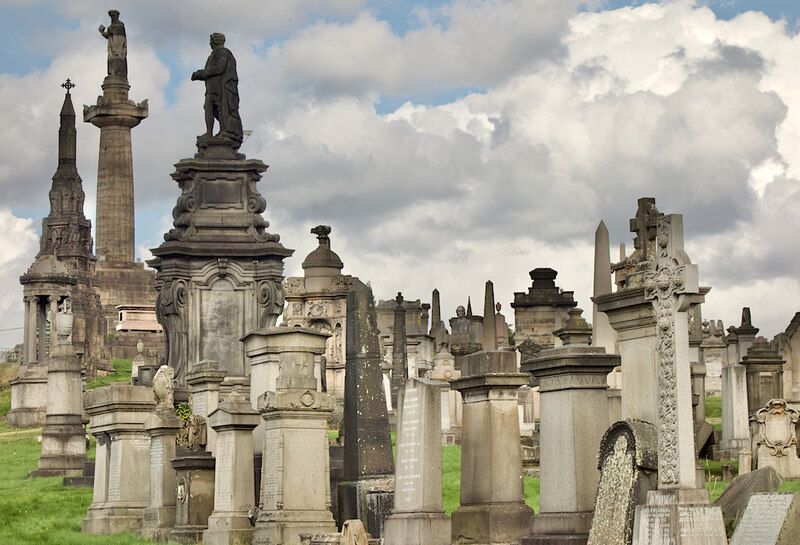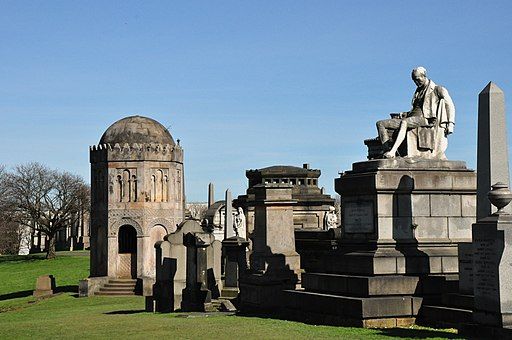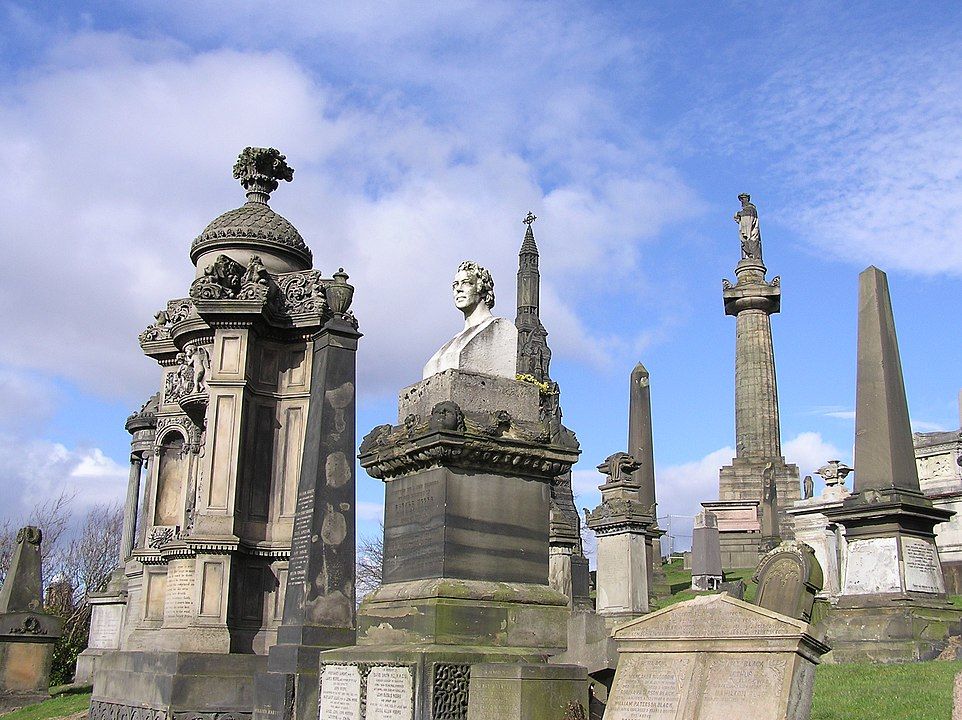Glasgow Necropolis is one of the main landmarks in the city’s history, and a visit that no traveler should miss out on. Celebrities, Victorian architecture, history-packed mausoleums, and breathtaking views upon Saint Mungo’s Cathedral and the Merchant City…all of this and even more awaits you in this iconic Glasgow location!
Glasgow Necropolis is a sprawling Victorian cemetery located on a hill east of the city center, beside St. Mungo’s Gothic cathedral. It hosts a whopping three thousand and five hundred mausoleums, with approximately fifty thousand people buried therein even though, of course, not all of them have their own gravestone. It is one of the finest historical landmarks in Glasgow, and a must-visit to understand the past of this cosmopolitan city, built from the ground up by middle and well-off classes devoted to overseas trade and shipyards.

Glasgow Necropolis background
After the Enlightenment, and especially during the early 1800s, there was a growing urge, both for the sake of hygiene and because of urban planning, to shift the location of downtown burial grounds and their surrounding churchyards towards the outskirts of cities.
The city of Glasgow would be one of the first in the entire United Kingdom to take action about this. Thus, following the due legislative overhaul (burials had pertained exclusively to the Church hitherto), the new Glasgow cemetery opened its doors in April 1883, beside a Jewish graveyard which had been inaugurated on the hillside a few months earlier.
The history of Glasgow Necropolis, which was soon referred to as the “City of the Dead”, would straddle throughout all the 1800s and well into the 1900s, sheltering the bodies of dozens of thousands of citizens, dotting the hill with elegant sculptures and funerary monuments which can still be visited to this day.
In 1996, the Chamber of Commerce gifted the Necropolis to the city of Glasgow for the enjoyment of all its citizens and visitors.

Architecture and remarkable sculptures
By and large, Glasgow architecture stands out for its Victorian buildings dating from the 1800s, a century of financial buoyancy, and its Necropolis is no exception. Some of the best designers and architects of that era contributed to creating its elegant mausoleums and the bridge leading to the entrance, known as the “Bridge of Sighs” (therefore inspired by its namesake in Venice) since it was used by funeral processions to enter the Necropolis.
As for the most remarkable monuments in Glasgow Necropolis, the statue of Protestant reformer John Knox, dating back to 1825, is worth mentioning (it thus precedes the graveyard itself), as well as the memorial to William Miller, a renowned Scottish poet who penned the nursery rhyme “Wee Willie Winkie”.
The Celtic cross-shaped gravestone devised by Charles Rennie Mackintosh for Andrew McCall is also worth mentioning (it is rather difficult to find, but definitely worth the effort). You will find it at the foot of the southern hillside in the cemetery!

Celebrities buried in the Necropolis
As underlined before, some of the most relevant historical characters in Glasgow are buried beneath its Necropolis. Such is the case of:
- Charles Tennant, a Scottish entrepreneur who became conspicuous for commercializing powdered bleach, founding a veritable empire in the local chemical industry. His funeral sculpture, in a nonchalant, unusual pose upon his gravestone, is amongst the most unique in the graveyard.
- William McGavin, an unfortunate entrepreneur and controversial preacher who still boasts a humongous monument to honor him in the Necropolis.
- Hugh Tennent, who in 1885, launched the production of the universally famous Scottish beer Tennent’s at Wellpark Brewery, with his gravestone facing its headquarters from the southern hillside of the Necropolis.

Cultural importance of Glasgow Necropolis
The Necropolis is one more testament to the enormous cultural importance that the city of Glasgow attained throughout the 1800s and the early 1900s. As stressed at the beginning of this article, this graveyard, inspired by the avant-garde Pére Lachaise cemetery in Paris, was the first of its kind in Scotland, and a pioneer in the United Kingdom. It serves as further proof of the power and relevance held by the bourgeois and the trading elite of a city which was regarded as the second most important hub in the British Empire!
It is also important to underscore that this Necropolis was one of the few at the time which made the effort to keep a register of the deceased buried within its grounds, not only including their names and date of death, but also the cause of their passing and their profession. A real gem for historical archiving!
Besides, the Necropolis is a fine showcase of Scotland’s heritage both culturally and also architecturally, since some of the best sculptors, architects, and designers at that time partook in its construction and evolution, featuring Alexander “Greek” Thomson, J. T. Rochead, and the aforementioned Charles Rennie Mackintosh.

Visits and guided tours
It is possible and highly advisable to visit Glasgow Necropolis, both on your own or with a guided tour hosted by the Friends of Glasgow Necropolis association. You can check further information on their official website and make your bookings there (try to do so as early as possible, since the vacancies fly!). Should you prefer to stroll through the graveyard on your own, but you still want to know all about it, the association also has printed guides at your disposal to make the most of your visit.
If you are also interested in getting to know the history, architecture, and unique street and urban art in the rest of this fascinating city, join one of our Glasgow free tours for further enjoyment!
Conclusion
To conclude, under no circumstances should you miss out on a visit to the Necropolis if you are in town, since it is one of the most famous and visited landmarks in Glasgow and, besides that, you could also explore the neighboring St. Mungo’s cathedral and the rest of the Merchant City.
We hope that you find this guide to Glasgow and its Necropolis useful, and you come visit it very soon!